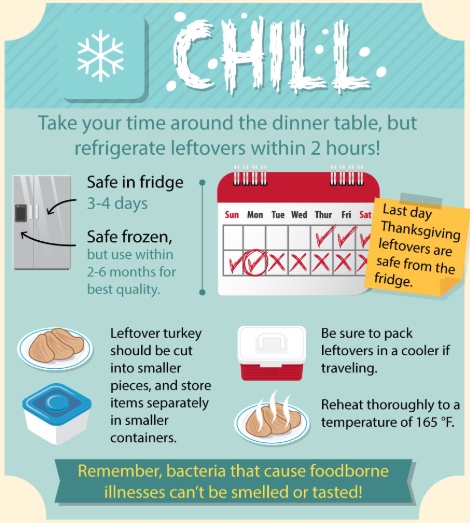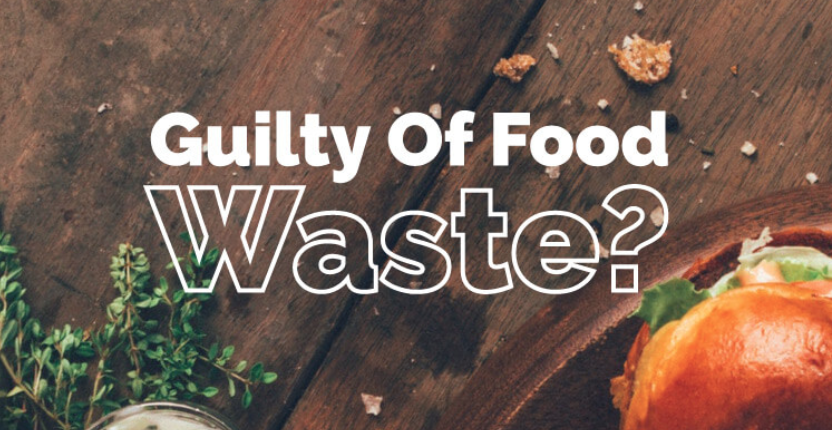If you want to help the environment by reducing waste, reducing the amount of food and food scraps you throw out is a big component.
According to a recent survey, if you could avoid toss out the average amount for a Connecticut household, that amounts to $873 a year, or over a fifth (21 percent) of what the normal household spends — you’d save money you could spend on yourself or others.
Joining the new Darien Food Scrap Recycling Program is one way to do it. In addition to that (or instead of it, if food scrap recycling is one additional task too many for you), just knowing when you don’t really have to throw out food may help you cut down on the amount. (In this article we’ve included information from experts about how safe it is to keep certain food refrigerated.)
A survey of how much food we throw out, broken down by state, was paid for by New York City-based Klein Kitchen & Bath, a remodel and design firm. A total of 3,200 people nationwide were questioned to find out how much they threw away this past year.
Connecticut households waste $873 worth of food annually, or in other words, over a fifth (21 percent) of their food each month — largely because it’s gone past its expiration date.
“It seems we need to educate ourselves a little better on what we can eat and when,” says Eric Klein from Klein Bath & Kitchen. “Just being familiar with the difference between, say, sell-by dates and use-by dates can help us be less wasteful.”
The misunderstanding of food labelling might be a huge factor in avoiding food waste. The survey found that nearly half of respondents (48.9 percent) won’t eat food that’s marked as past its sell-by date – but perhaps that’s because they are misinformed about what the sell-by date actually means – it is the last date by which it must be sold in a store; however, after that, it’s still good to eat (even if it’s past what’s marked as the use-by date).
Again, the label – use-by date – caused confusion: Only one-quarter knew that it signifies the last date for use of the product at its peak quality.
Nearly a third (30.4 percent) believed that it was the last date the product was edible, almost a quarter (22 percent) thought it meant that it was the last date the food product could be displayed and sold in a store.
Another 21 percent thought it meant the date that the product would be at its best flavor and quality — when, in fact, this is the ‘best-by‘ date (interestingly, while these guides are in place, they don’t actually say that this is the last date a product can be eaten by – that part is up to you, the consumer.
You can eat something beyond the guidelines, but just give it a check over, or a ‘sniff test’ first before eating).
Over half (51.1 percent) of people believe that best before dates on fruits and vegetables should be scrapped altogether because they say it’s easy to tell if something has gone off just by touching it. The survey also found that the foods Americans would be most likely throw away are dairy products (46.6%); followed by meat (22.3 percent); fish (19.2 percent); bread (5.1 percent) and vegetables (8.5%).
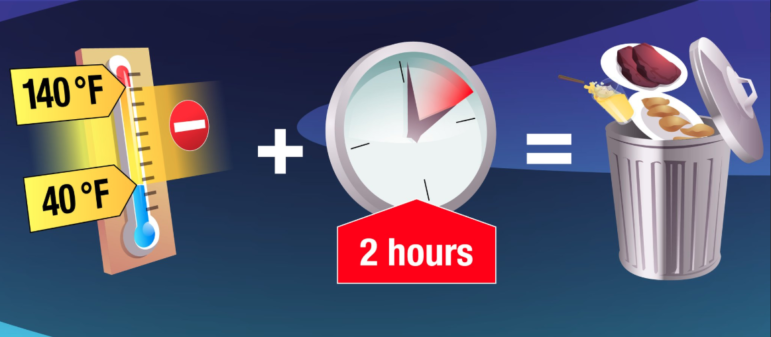
If you know when to throw out bad food and when not to, you’ll both be safer and, through planning (like getting it in the refrigerator or freezer in time), waste less.
More Tips on Reducing Food Waste
Klein Kitchen & Bath have provided advice below on how you can be more resourceful with your food, and so hopefully will be able to throw less away in the future:
- Freeze your food. You can actually freeze the food right up till the use-by date, and it will be good to eat months later! (Just double check what you can or can’t freeze – not everything can go in, like soft cheeses).
- Freeze milk into an ice cube tray! As the survey revealed, most people will throw away dairy products first – well now they can use this handy tip instead of wasting. Use the frozen milk cubes in coffee or tea!
- Put your herbs into a glass of water to prevent them from wilting quickly, they will last much longer!
- If yogurts are getting near their use-by date, you can mix them up with some over-ripe fruit for a smoothie or even freeze into ice-lollies!
- Turn stale bread or crusts into breadcrumbs by putting them in a food processor. Fantastic when mixed with herbs or onions as a stuffing for chicken or to top baked fish!
- When cooking with foods such as potatoes, broccoli, or carrots, use it all. You don’t need to remove the peel or cut the stems off, as they often have additional nutrients in! And if you don’t like the peel or stem, you can compost what you don’t use.
- Donate the items you might be close to throwing out which aren’t yet out of date. There will be plenty of food kitchens nearby that would really appreciate anything you have which is going spare.
More About the State-by-State Comparisons
(The data was calculated by using the amount spent annually by each American household,a figure taken from the Bureau of Labor Statistics), and asking households how much food they throw away at the end of every month (to get the percentage.)
Broken down by state, the survey found that South Carolinians are the most wasteful, who get rid of $1,304.68 worth of food every year. The least-wasteful state is West Virginia, whose residents only throw away $404.90 worth of their annual groceries. Klein Kitchen & Bath also wanted to find out how their home state of New York fared; and overall, New Yorkers dispose of $958.97 of their food per year.
__________________________
Know When to Throw Out (and When Not to)
From the blog at the U.S. Department of Agriculture’s Food Safety.gov website (images in this article are from the USDA Food Safety Twitter account):
Food waste by consumers may often result from fears about food safety caused by misunderstanding of what food product dating actually means, along with uncertainty about storage of perishable foods.
Understanding Food Product Dating
Except for infant formula, dates on food products are not required by any Federal law or regulation, although some states do have requirements for them.
Most of the food dates consumers see are on perishable foods, that is, foods likely to quickly spoil, decay, or become unsafe to eat if not kept refrigerated at 40 F° or below or frozen at 0 F° or below.
Perishables include meat, poultry, fish, dairy products, fresh eggs, and fresh fruit and vegetables. Makers/packers of perishable food use them to help ensure that consumers buy or use their products while they are at what the maker/packer considers their best quality.
- A Sell by date indicates that a product should not be sold after that date if the buyer is to have it at its best quality.
- A Use by or Best by date is the maker’s estimate of how long a product will keep at its best quality.
- They are quality dates only, not safety dates. If stored properly, a food product should be safe, wholesome and of good quality after its Use by or Best by date.

Image from USDA Food Safety account on Twitter
Safe Keeping …
Learn How to Store Perishables and How Long They Will Keep Safely
This chart is from the USDAFoodSafety account on Twitter:
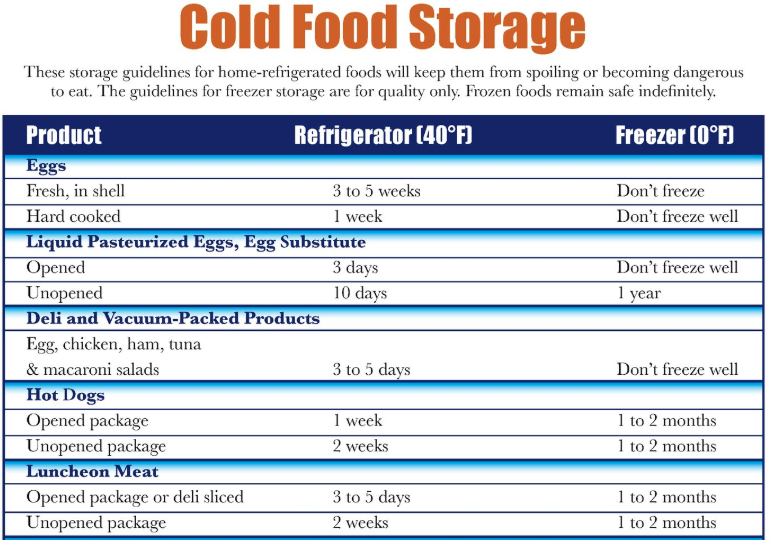
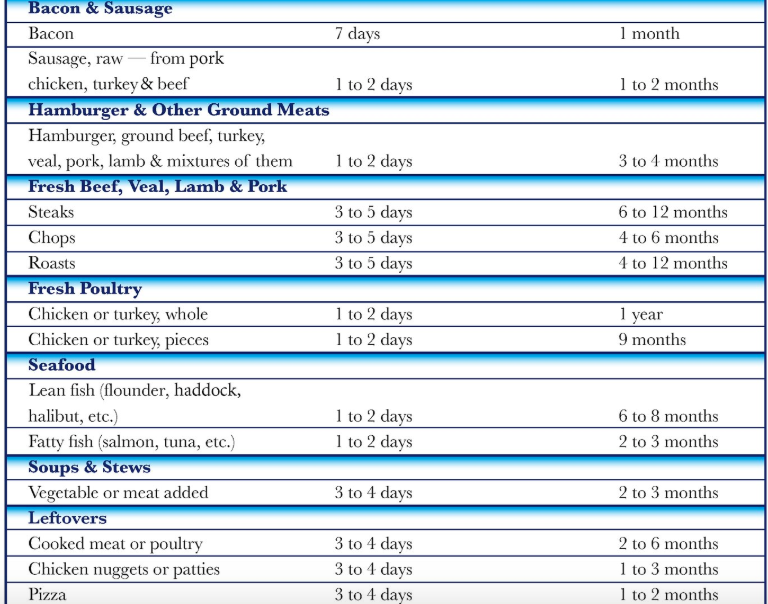
FoodKeeper App
The FoodKeeper App, developed cooperatively by the U.S. Department of Agriculture, Cornell University, and the Food Marketing Institute, is a complete guide to how long virtually every food available in the United States will keep in the pantry, in the refrigerator, and in the freezer.
The Fresh Fruits section, for example, covers apples (3 weeks in the pantry, 4 – 6 weeks in the fridge, and—only if cooked—8 months in the freezer) to pomegranates (2 – 5 days pantry, 1 – 3 months fridge, and 10 – 12 months freezer).
The Meat, Poultry, and Seafood sections are equally complete, and include smoked as well fresh products.
Access the FoodKeeper App or download it as a mobile application:
Warning: If food is obviously spoiled—it’s abnormally soft, discolored, moldy, or has a strong unpleasant smell—discard it, no matter how properly or how short a time it has been stored.
